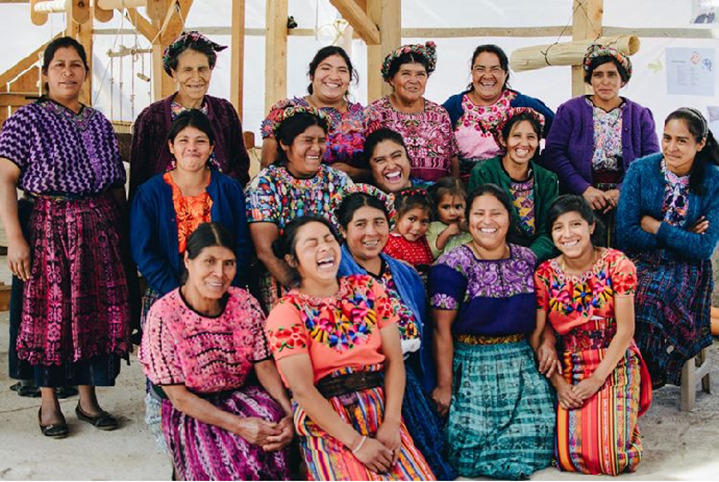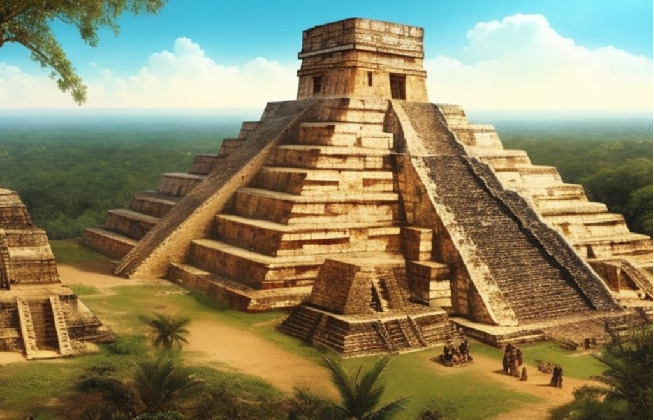We’ve all heard about the Mayan calendar and the sensational prediction that the world would end in 2012. The Maya civilization, however, is shrouded in much more than just doomsday prophecies. This ancient culture is a treasure trove of mysteries and marvels that continue to captivate historians and archaeologists alike. From their advanced knowledge of astronomy and mathematics to their intricate architectural feats, the Maya left behind a legacy filled with enigma and wonder.
The Maya civilization is renowned for architecture, including one of the New Seven Wonders of the World called Chichen Itza. Nestled in the Yucatán Peninsula of Mexico, this ancient city is a testament to the Maya’s advanced engineering and astronomical prowess. The iconic pyramid of El Castillo, with its precise alignment to celestial events, and the mysterious Temple of the Warriors are just a few of the awe-inspiring structures that continue to draw visitors and scholars from around the globe, to unravel the secrets of culture.
Maya science and their belief in God
The ancient Maya were adept astronomers, and their profound knowledge of celestial bodies is evident in their architectural achievements. Many Maya structures were meticulously aligned with astronomical events, such as solstices and equinoxes. This alignment served not merely an aesthetic purpose but was also a means for the Maya to establish a connection with their deities and to mark the passage of time. These architectural orientations facilitated the observation of significant celestial phenomena, underscoring the Maya’s sophisticated understanding of astronomy and its integral role in their cultural and religious practices.
I believe that every scientific discovery made by the Maya is intertwined with their culture and society, reflecting how they shaped and understood their world. The Maya’s achievements in astronomy, mathematics, and agriculture were not just technical feats, they were integral to their daily lives, religious beliefs, and social organization. For instance, their intricate calendar systems were used to plan agricultural cycles, religious ceremonies, and political events, illustrating a harmonious blend of science and spirituality. This synergy between their discoveries and cultural practices shows how the Maya created a sophisticated and interconnected way of life.
The Maya’s advanced astronomical knowledge laid the groundwork for modern astronomy. Their observations of celestial bodies and phenomena, such as eclipses and planetary movements, have been integrated into contemporary astronomical studies. The ancient Maya discovered astronomy through their strong belief in their gods, which they saw reflected in the stars, moon, and planets, particularly Venus, as noted by Christopher Minster on the ThoughtCo website. They built structures with astronomical alignments, reaching a peak in the 8th century CE. Detailed astronomical tables were created at Xultun and Guatemala in the 9th century and appear in the 15th-century Dresden Codex.
The Maya saw Earth as the universe’s fixed center, with celestial bodies as gods influencing human affairs. They accurately tracked the sun, moon, and planets, especially Venus, which was crucial for timing battles. Stars were important for agricultural planning. Maya architecture, including temples and observatories, was aligned with celestial events, demonstrating their profound integration of astronomical knowledge into their cultural and religious practices.
From this discovered background, we understand that the Maya’s achievements in astronomy and mathematics were interconnected with their cultural and religious practices. Their sophisticated understanding of the cosmos not only enhanced their scientific and mathematical capabilities but also reflected their worldview, where celestial bodies were seen as divine influences on human affairs. This synergy highlights how the Maya seamlessly blended scientific discovery with spiritual significance, creating a harmonious and sophisticated way of life.
In my research on the article “Maya Mathematics,” focusing on the concept of zeros, I explored how the Maya utilized mathematics to calculate their calendar, which intertwined with their astronomical observations and religious beliefs. The Maya’s innovative use of zero was fundamental to their mathematical system, enabling complex calculations and precise data recording. In turn, facilitated the development of their advanced calendrical system, which incorporated both astronomical phenomena and religious significance.
Maya astronomy was intricately intertwined with their religious beliefs. They perceived celestial bodies like the sun, moon, planets, and stars as gods, believing their movements reflected divine will. Observing the heavens was a means of understanding the gods’ intentions and predicting important events. Maya rulers used astronomical knowledge to reinforce their divine connection, associating themselves with celestial bodies to legitimize their power. Thus, Maya astronomy served not only as a scientific pursuit but also as a means of interpreting and venerating their gods.
Maya architecture inspiration
The Maya are renowned not only for their astronomical achievements but also for their impressive architecture. They built numerous structures throughout their empire, many of which resemble the iconic pyramids of Egypt. This architectural prowess is fascinating, as it demonstrates how ancient Maya designs have inspired modern Maya architecture. The intricate construction techniques and aesthetic principles developed by the ancient Maya continue to influence contemporary architectural practices, showcasing a blend of historical significance and enduring cultural legacy.
Mayan architecture is celebrated for its complexity and engineering prowess and integrates astronomy. Architects and scientists have extensively studied Mayan structures such as Chichen Itza, uncovering intricate mathematical and astronomical principles guiding their construction. One notable feature is the frequent depiction of Chaac, the Mayan god of rain and water, on buildings and artifacts. Chaac masks adorn pre-Hispanic structures, particularly in the Puuc architectural style prevalent in the Yucatan Peninsula.
The Mayan Arch, or “false arch,” is another distinctive element of Mayan architecture, often used to emphasize main entrances. Combined with the Mayan Vault, these arches create grand passageways that enhance building height and structural integrity. Circular and oval structures, like the Observatory at Chichen Itza, were meticulously designed with symbolic and functional purposes, frequently adorned with Chaac masks.
Mayan homes also incorporate oval shapes, which serve to withstand strong winds and hurricanes, illustrating the Maya’s thoughtful consideration of environmental factors in their architectural designs. This blend of functional innovation and cultural symbolism underscores the Maya’s profound architectural legacy, influencing both ancient and contemporary architectural practices.
Modern architects frequently find inspiration in Maya pyramids when designing contemporary structures. The stepped pyramids, precise alignments, and intricate carvings of Maya architecture offer rich aesthetic and functional elements that resonate with today’s architectural trends. Whether incorporating geometric shapes, intricate patterns, or sustainable building techniques inspired by ancient Maya engineering, the influence of Maya pyramids can be seen in skyscrapers, museums, public plazas, and residential homes worldwide. This fusion of ancient wisdom with modern design principles not only produces visually striking buildings but also honors the enduring legacy of the Maya civilization.
If we consider modern architecture to be influenced by Maya architectural principles, it is essential to mention Frank Lloyd Wright Sr. (1867-1959), a renowned American architect, interior designer, writer, and educator. Wright was significantly influenced by various architectural styles and cultural traditions throughout his career, including the architecture of ancient civilizations. Notably, one of these influences was Maya architecture. Frank Lloyd Wright Sr. was inspired by the grandeur and permanence of Maya structures. This is evident in some of his larger projects which have a monumental quality, such as the Unity Temple in Oak Park, Illinois, which has a strong, solid, block-like appearance. He use of geometric forms can be traced to his admiration for the geometric precision in Maya architecture. His designs often feature strong horizontal and vertical lines and intricate geometric patterns, as seen in the textile block houses he designed in Los Angeles.
While Wright generally favored a more minimalist and functional approach compared to the highly decorative Maya style, he still incorporated ornamental details that echoed the intricate patterns found in Maya carvings.
Frank Lloyd Wright Sr. philosophy of organic architecture, which emphasizes harmony between human habitation and the natural world, is somewhat parallel to the Maya’s integration of their buildings with the landscape. Wright designed structures that often appeared to grow naturally out of their surroundings. Falling water is a quintessential example of this philosophy, where the house is built over a waterfall, blending seamlessly with its environment.
Frank Lloyd Wright Sr. inspired by the geometric forms and relief ornamentation of Maya architecture, the Ennis House (1924) features concrete blocks with patterns that evoke the intricate stone carvings of Maya buildings. Another of Wright’s textile block houses, the Millard House (La Miniatura) (1923) incorporates patterned concrete blocks and a design that reflects both the solidity and the decorative aspects of Maya architecture. For instance, the influence of Maya architecture can be observed in notable structures like the Four Fifty Sutter Building, a twenty-six-floor skyscraper in San Francisco completed in 1929, and the Imperial Hotel in Tokyo, Japan, built in 1880, among others. These buildings reflect the timeless appeal and innovative spirit of Maya architectural forms, demonstrating their ongoing impact on global architecture.
We can conclude that Maya architecture, for both ancient and modern, embodies a remarkable fusion of ingenuity, cultural symbolism, and enduring influence. Ancient Maya structures integrated astronomy and spiritual beliefs, seen in features like Chaac masks and innovative designs such as the Mayan Arch and Vault. These buildings were not only functional but also expressed deep environmental considerations.
Today, modern architects worldwide draw inspiration from Maya architecture. The stepped pyramids, precise alignments, and intricate carvings continue to influence contemporary designs in skyscrapers, museums, and homes. This blend of ancient wisdom with modern aesthetics celebrates innovation, sustainability, and cultural heritage, affirming the lasting impact of Maya civilization on global architecture. Maya architecture remains a testament to their timeless creativity and sophistication.
Relationship between Ancient and Modern Maya
Ancient Maya education was primarily transmitted through oral tradition and practical experience within family and community settings. It focused on passing down knowledge of agriculture, mathematics, astronomy, and religious rituals from one generation to the next.
In modern Maya education, we see the enduring influence of traditional knowledge, particularly in the context of mathematics. In the village of Celtún, located in the Yucatán state of Mexico, eight-year-old Verónica Yuritzi Martín Puc exemplifies this unique approach to learning mathematics. Her classroom experience reflects a blend of ancient Maya mathematical concepts and contemporary teaching methods, highlighting how traditional knowledge is integrated into modern education.
This approach not only preserves the rich mathematical heritage of the Maya but also makes learning engaging and relevant for today’s students. By combining ancient techniques with modern educational practices, Verónica and her peers gain a deeper understanding of mathematics, rooted in their cultural heritage. This method ensures that the legacy of Maya mathematics continues to thrive and inspire new generations. There’s a growing recognition of the importance of Maya history and language in formal education, fostering a sense of pride and cultural identity among Maya youth.
Maya architecture displayed impressive engineering and artistry with structures like pyramids, palaces, and observatories. These buildings had ceremonial, administrative, and residential purposes and featured symbolic elements and intricate carvings. Today, Maya architecture inspires modern designs blending ancient techniques with sustainability. The usage of Maya motifs in public buildings, homes, and cultural centers shows an appreciation for cultural heritage while adapting to current needs.
The ancient Maya were renowned astronomers, observing celestial bodies with remarkable accuracy and integrating astronomical knowledge into their calendar systems and religious practices. Modern Maya communities maintain an interest in astronomy as part of cultural identity and spiritual heritage. There’s ongoing research into ancient Maya astronomical achievements, such as the tracking of planetary movements and solar eclipses, which continues to inform contemporary astronomical studies. Maya astronomical symbols and concepts remain significant in cultural ceremonies and celebrations, emphasizing a continuity of knowledge and reverence for celestial phenomena.
The ancient Maya were skilled astronomers, using celestial bodies to develop their calendar systems and religious practices. Modern Maya communities continue to value astronomy as part of their cultural identity. Ongoing research explores ancient Maya achievements in tracking planetary movements and solar eclipses, informing contemporary astronomical studies. Maya astronomical symbols and concepts are still important in cultural ceremonies and celebrations, highlighting the continuity of celestial knowledge.
We can conclude that the relationship between ancient and modern Maya civilizations in education, architecture, and astronomy consists of knowledge, innovation, and cultural resilience. While modern Maya society embraces technological advancements and global influences, it also cherishes and revitalizes traditional practices and knowledge systems, ensuring that the rich legacy of the Maya civilization endures and evolves in meaningful ways.
Butsabakorn Lamthaisong is a M.Sc. student in Mathematics, University of Southern Denmark












